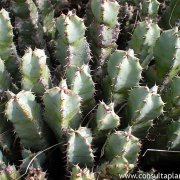Care of the succulent plant Euphorbia resinifera or Resin spurge |
|
The genus Euphorbia, family Euphorbiaceae, includes 2,000 species of succulents, trees, shrubs, and herbaceous plants of cosmopolitan distribution. Some species are: Euphorbia resinifera, Euphorbia viguieri, Euphorbia meloformis, Euphorbia lomelii, Euphorbia tithymaloides, Euphorbia obesa, Euphorbia milii, Euphorbia mammillaris, Euphorbia leucocephala, Euphorbia lactea, Euphorbia ingens, Euphorbia inermis, Euphorbia horrida, Euphorbia heptagona, Euphorbia handiensis, Euphorbia grandicornis, Euphorbia flanaganii, Euphorbia enterophora, Euphorbia enopla, Euphorbia echinus, Euphorbia cotinifolia, Euphorbia coerulescens, Euphorbia bubalina, Euphorbia characias, Euphorbia candelabrum, Euphorbia canariensis, Euphorbia pulcherrima, Euphorbia regis-jubae, Euphorbia royleana, Euphorbia trigona, Euphorbia bivonae, Euphorbia rigida, Euphorbia handiensis, Euphorbia balsamifera. Common names: Resin spurge, Officinal Spurge, African Spurge, Gum euphorbia, Moroccan Mound. This species is native to the Atlas Mountains, Morocco. They are slow-growing succulent plants that can form large colonies 50 cm (1.64 feet) high by 150 cm (4.92 feet) in diameter. The stems branch from the base and are erect, green-gray in color and have 4 spiny edges. They produce small, intense yellow flowers. Resin spurge is used in rockeries, on sandy slopes and in cactus and succulent gardens. Euphorbia resinifera needs full sun exposure and a warm climate. It resists occasional frosts down to -5 ºC (23 ºF). The soil can be a mixture of leaf mulch or peat with commercial cactus substrate. Water moderately waiting for the substrate to be completely dry. Water very little in winter. African Spurge does not need pruning or fertilizers. Euphorbia resinifera is a plant resistant to the usual pests but sensitive to excess humidity. Gum euphorbia propagates by cuttings that are allowed to dry a week before planting to avoid contact with irritating latex. |
Images of the succulent plant Euphorbia resinifera or Resin spurge |
Find plants
Euphorbia resinifera or Resin spurge | Care and Growing
© 2025 FavThemes





